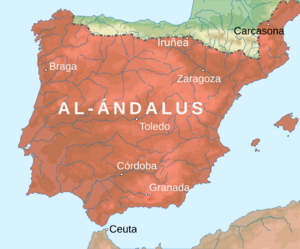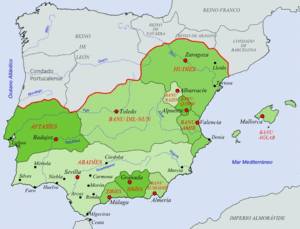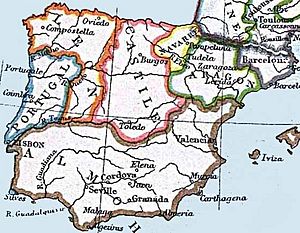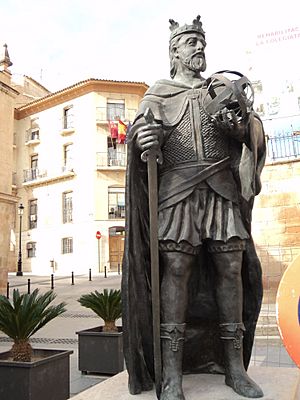Al-Azraq Treaty of 1245 facts for kids
The Al-Azraq Treaty of 1245 was a peace agreement signed between the Christian King James I of Aragón, his son-in-law Prince Alfonso X of Castile, and the Muslim leader Abū 'Abd Allāh Muhammad ibn Hudhayl, also known as al-Azraq. It was signed on April 15, 1245, in Valencia, a city in what is now Spain. This treaty is special because it is one of only two old Muslim-Christian surrender treaties that still exist today and are written in two languages. King James I believed this treaty marked the end of the reconquista, a long period when Christian kingdoms took back land from Muslim rule in the Iberian Peninsula.
Contents
What Was Happening?
Muslims and al-Andalus
The Umayyad Caliphate
Muslim and Arab armies from Northwest Africa, led by Ṭāriq ibn Ziyād, conquered a region called al-Andalus between 711 and 718 C.E. Before this, the area was controlled by the Visigoths. After the Battle of Guadalete, al-Andalus became part of the Umayyad Caliphate. This caliphate later broke into 23 smaller kingdoms called taifa kingdoms in 1031. These small kingdoms often fought against the Christian lands in the north.
Many Christians moved north and created the kingdom of Asturias. This kingdom later split into Castile, Galicia, and León. The Asturians defeated the Umayyads at the Battle of Covadonga in 722. Many historians say this battle was the start of the Reconquista. Over time, the Umayyads lost more land, including Galicia (739) and León (754).
A powerful Muslim leader named al-Mansur led many attacks into Christian areas. He wanted to expand Muslim rule across Spain. In 997, al-Mansur ordered the destruction of a church in León that was important to Christians. The church was taken apart, and its doors and bells were moved to a mosque in Córdoba. By 1031, the Umayyad caliphate in al-Andalus had completely fallen apart.
The Almoravid Dynasty
In 1089, the Asturians captured Toledo. The Muslims in al-Andalus asked for help from the Almoravid Muslim Dynasty. The Almoravids stopped the Christian advance at the Battle of Sagrajas in 1086. However, under the Almoravids, Christian forces still managed to capture Zaragoza (1139) and Lisbon (1147).
The Almohad Caliphate
The Almohad Caliphate took over from the Almoravids in 1147. They lost a lot of land to Christian armies after their defeat at the Battle of Las Navas de Tolosa in 1212. After this, they lost many important cities like Córdoba (1236), Valencia (1238), and Seville (1248).
The Nasrid Dynasty
The Nasrid Dynasty was formed in 1232. Their territory kept getting smaller as Christian forces captured more cities. The capture of Grenada in 1492 marked the end of Muslim rule in the Iberian Peninsula. Muslims had controlled parts of this region for about 781 years.
The Catholic Church's Role
In the 11th century, the Catholic Church began to call Muslims "infidels." This was a way to unite Christians against a common enemy. The Church in Rome and other Christians wanted the wealth of southern Spain, which was mostly controlled by Muslims.
Military campaigns began in Aragón and Castile to push Muslims out. These actions, led by the Church, grew into a full crusade. They also set the stage for the Crusades to the Holy Land and the Inquisition. Pope Urban II even tried to send crusaders from Jerusalem to al-Andalus, calling the Muslims a "threat."
In the 1100s, Pope Urban II offered special rewards called indulgences to those who fought in Spain. These were the same rewards given to crusaders going to the Holy Land. By the 1200s, fighting "infidels" in Spain was seen as just as important as fighting in the Holy Land.
The Inquisition became a special task for three different monastic groups. The Dominicans took charge of it in 1233. This was when the Spanish Inquisition began to take its well-known form. After Christians captured Córdoba in 1236, they built a church on top of the mosque. They also forced Mudéjars (Muslims living in Christian lands) and Jews to convert to Christianity.
In 1492, King Ferdinand and Queen Isabella ordered all Jews to leave Spain. This led to many Muslims and Jews, including those who had converted, leaving the country. The Inquisition finally ended in 1834.
Living Together: Different Religions
Historically, people from different Abrahamic faiths (Muslims, Jews, and Christians) often lived and even married together. The Al-Azraq Treaty shows how these groups could work together. For example, Jewish scribes in the Christian government wrote the Arabic part of the treaty.
Leaders from different religions also worked together if it helped their lands. For instance, the Abbasid dynasty in Baghdad asked Charlemagne to attack the Umayyads in al-Andalus. Jews often preferred Muslim rule because they found it more tolerant than Christian rule. Many Jews moved to al-Andalus from other parts of Europe.
In 1235, Pope Gregory IX issued a special order called cum hora undecima. This order allowed Christian preachers to let people who had rejoined the Church live and interact with their non-Christian relatives. This order was reissued in 1245 by Pope Innocent IV, the same year the Al-Azraq Treaty was signed.
How the Treaty Came About
King James I was a strong supporter of the crusade against the Muslims in Valencia. This war started in 1232 and ended with the Al-Azraq Treaty in 1245. James I used his many vassals (nobles who promised loyalty and service in exchange for land) to build his army. He also used siege warfare, which meant surrounding a city or fortress until it surrendered. This was less risky than direct battles.
His strategy was to attack the strongest fortresses and also to scare the people nearby. Sometimes, cities would surrender without a fight because they feared James I. He was known for offering fair surrender terms, like allowing defeated Muslims to leave with their belongings.
Muslims, on the other hand, often used raiding tactics, which also had low risk. They also hired mercenaries and got help from the Almohad Caliphate in North Africa. The city of Valencia fell to James I in 1238 after a long siege. James I also bribed one of al-Azraq's advisors, which left al-Azraq unable to pay his soldiers. Historians believe that the Muslims lost al-Andalus partly because their military relied too much on outside help, while the Christian forces were experienced and well-organized.
The Al-Azraq Treaty Itself
The treaty is a thin piece of parchment, about 25 by 40 centimeters. It is torn where Alfonso's seal used to be. The Arabic lines are not just a translation of the Castilian lines. Instead, they continue the treaty, mixing with the Castilian parts to complete the document. Each part of the treaty has a different feel. The Castilian part sounds like a partnership where al-Azraq is serving Alfonso, while the Arabic part sounds more like a simple truce.
The Castilian Lines
The fourteen lines in Castilian (which has some Aragónese influence) are written closely together. They form the first and last parts of the treaty. This section is divided into two parts:
Al-Azraq's Part
- Al-Azraq agrees to be Alfonso's vassal, meaning he will serve Alfonso.
- Eight castles and their lands are given to Alfonso when the treaty is signed.
- Al-Azraq's family gets to keep the castles of Alcalá and Perpunchent, which were his main territories.
- He can keep his other four castles for three years. He must give half of their profits to Alfonso right away.
- After three years, all the money from these castles goes to Alfonso.
- Al-Azraq can also take more castles from other rebels. If he does, he must give half the money to Alfonso immediately and all of it after three years.
Alfonso's Part
- Alfonso accepts al-Azraq as his vassal.
- Two castles are given to al-Azraq.
- Al-Azraq also gets the money from the villages of Ebo and Tollos for three years.
- The Castilian lines end with Alfonso promising to honor the treaty as long as al-Azraq remains his loyal vassal.
The Arabic Lines
There are thirteen lines in Arabic, written in Maghribī script. They look larger, more spread out, and fainter because the ink has faded.
- The Arabic part has a business-like tone. It does not mention al-Azraq being a vassal, unlike the Castilian lines.
- The only hint that al-Azraq has a lower status is when Alfonso is called "the Exalted Prince."
- There is no specific time limit mentioned, except that al-Azraq could keep his main castles for "the duration of the reign of the Exalted Prince."
- Al-Azraq's rights are then clearly listed.
This was not the first time a Christian king tried to make a defeated Muslim leader his vassal. A peace treaty between Alfonso VIII of Castile and Zayd, a king of Valencia, also included a vassal agreement. However, al-Azraq was also not the first Muslim leader to break such an agreement.
What Influenced the Treaty?
Several things affected the treaty's words and terms:
- Al-Azraq was surrounded: His allies in North Africa were fighting their own wars and could not help him. Other Muslim strongholds like Xátiva and Dénia had already surrendered to James I.
- James I's concerns: King James I's land was being taken by Francia (modern-day France). He needed to finish the war in Valencia to protect his borders. He had a plan to regain territory through a marriage, but it did not work out.
- Another Crusade: Pope Innocent IV had called for a new crusade to help Jerusalem, which crusader armies had lost in 1244. King Louis IX of France joined this crusade. Since James I and Louis IX were rivals, James I decided to start his own crusade. He planned to "rescue" Byzantium on his way to Jerusalem. This crusade was set to begin in 1246.
James I needed to end the Valencian Crusade quickly so he could move his troops to defend Aragón and prepare for his own crusade. Al-Azraq had no more allies and had to accept the surrender terms. The treaty was quite fair to al-Azraq because James I did not know how close his opponent was to defeat.
Feudalism's Influence
Feudalism was a system where land was given in exchange for loyalty and service. It developed in Western Europe around the 10th century. This system created a new class of powerful warriors who served their kings. It also meant that wealth and power became concentrated in the hands of a few rich farmers and merchants.
In the Islamic world, vassalage was not common. The closest thing was Mamlukism, where enslaved men, often from Central Asia, were trained as elite soldiers. They were kept separate from local people to ensure their loyalty to their Sultan. This difference is why the Arabic part of the treaty does not mention vassalage.
What Happened Next?
New Laws
After the conquest, James I introduced new laws in Valencia. These laws were influenced by old Roman laws. For example, in 1238, he issued the Regni Valentie, a code of laws for Valencia. It listed many actions as "treasonous."
In 1242, James I made decrees protecting converts to Catholicism. He said people could not insult them by calling them "renegades." He also declared that Muslim family members could not take property from a convert. In 1247, another law code, the Fueros de Aragón, was written in the local language. It stated that anyone who did not follow the laws was committing treason against the king.
In 1256, a Christian town called Alcoi was built in a mostly Muslim area. This town was meant to defend Valencia from attacks by al-Azraq. Even though Christians lived in Alcoi, Muslims continued to own land around the town.
The Mudéjar Revolt of 1247
In 1247, two years after the treaty, al-Azraq and his troops started a revolt that lasted until 1258. Some historians call this a "counter crusade." In December 1247, James I ordered all Mudéjars (Muslims living in Christian lands) to leave Aragón, Catalonia, and Valencia. This happened after al-Azraq took control of several castles in Valencia.
While many church leaders and citizens supported this expulsion, James I's nobles were against it. Many of their tenants were Mudéjars, and expelling them would cost the nobles money. Muslims began rioting across Valencia, and more castles fell to their forces. James I then marched many Mudéjars to Castile and Granada.
As the war continued, Muslim forces in northern Valencia defeated a Christian army. In the south, they attacked Christian defenses. In 1248, James I led sieges against Muslim cities, relieved besieged castles, and killed a rebel leader. They also pushed al-Azraq's forces back to his base at Alcalá.
Pope Innocent IV often got involved, sending church members and asking for money to help James I. In November 1249, he issued a "crusade circular." It said that Muslims were "infidel people" who were persecuting Christians. He promised that anyone who fought for James I against the Muslims would receive "full pardon of their sins." This meant the war became a full crusade.
At one point, al-Azraq reportedly told James I he wanted to become Christian and marry a relative of a lord. James I rode to al-Azraq's castle, but his small group was ambushed, and the king almost died. The exact date of this event is not known.
In 1250, al-Azraq sent a letter to Queen Violante, acknowledging James I's rule over Valencia. Both sides sent representatives to talk. Pope Innocent IV continued to send letters, offering indulgences for those who fought in Spain. This meant James I was negotiating with his enemy while also seeking more crusade support from the Pope.
A truce was made in February 1258. Al-Azraq formed an alliance with Alfonso X, which led to James I's final push between 1257 and 1258. James I besieged Alcalá, and its defeat ended the war with a Christian victory. A new treaty was signed in July 1258, and al-Azraq was sent away to North Africa. This war also ended partly because James I bribed someone close to al-Azraq, cutting off his funds.
In his own writings, James I tried to downplay the revolt, saying it lasted only "three or four years" instead of ten. He was also the first to call al-Azraq "Our traitor" because he broke the treaty. Al-Azraq returned to the Iberian Peninsula in 1260 to lead another Muslim revolt. He was killed at the Battle of Alcoi in 1276.
See also
 In Spanish: Tratado del Pouet para niños
In Spanish: Tratado del Pouet para niños








